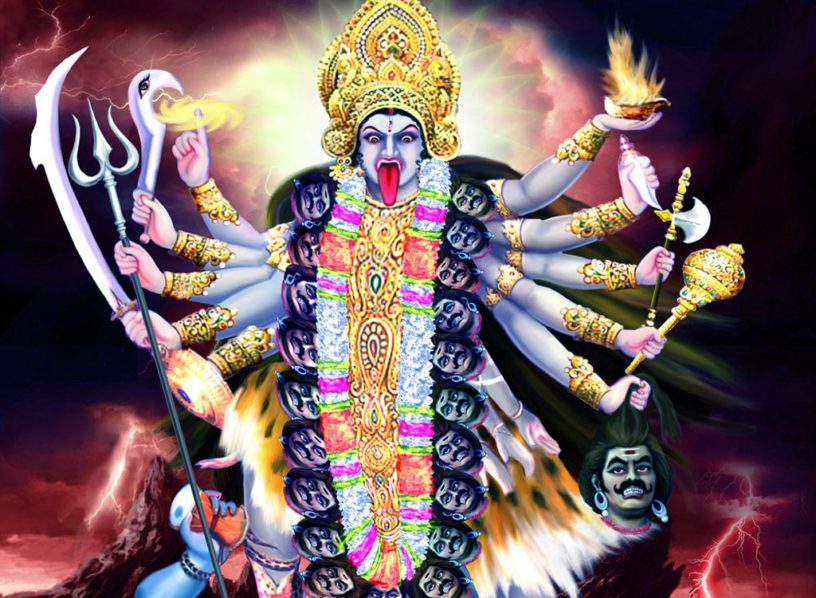The purpose of spiritual fulfilment through sadhana (spiritual practices) is to attain a state of full union with the Supreme Reality of God. This Supreme Reality is beyond any attribute or conceptual understanding. It is representative of transcendental knowledge and it projects itself, according to Tantra Shastra, as divine expressions in creation. These are the 10 cosmic powers and personalities of the Divine Mother. They are termed the Das Mahaa Vidyaa. Each aspect has a specific cosmic function and leads to a special realization of the one Reality. These cosmological laws, a body of universal laws, are relevant for all time. These are the 10 powers to which humans are subjected, and they are represented by the 10 forms of Devi:
- Kaali, the power of time
- Taaraa, the power of hunger
- Shodasi, the power of perfection
- Bhuvaneshwari, the power of knowledge
- Chinnamastaa, the power of sacrifice
- Bhairavi, the power of death
- Dhoomaavati, the power of poverty
- Bagalamukhi, the power of cruelty
- Maatangi, the power of domination
- Kamala, the power of wealth
Kaali, Unchanging and Beyond Time
The form of Kaali Maa is representative of profound spiritual truths. She is depicted as being black in colour, with a protruding tongue and wearing a garland of human heads. She holds a severed head as well as a bowl collecting its blood. She is armed with a trishul (trident), a sword and various other emblems.
The word, ‘kaal’ means ‘darkness’, ‘time’ as well as ‘death’. ‘Ee’ represents ‘shakti’ or ‘divine power’ and ‘energy’. Kaali removes the spiritual darkness from every individual who strives to be on the path of spiritual perfection. Black is the colour into which all colours merge; black absorbs and dissolves them. Similarly, Kaali is black, symbolising her all-embracing, comprehensive nature. She is as unknowable and as vast as darkness. All names and forms disappear in her; she is beyond knowing. Also, black is said to represent the total absence of colour, signifying the nature of Kaali as the Ultimate Reality, that infinite Shakti. From another perspective, ‘kaal’ means ‘time’ and ‘ee’ means ‘the cause’. Kaali is the cause of time but she is also beyond time.
Kaali Removes Imperfections
Kaali wears a garland of human skulls representing impure thoughts. She, who absorbs everything, severs the head of imperfections and negativities from our minds. Her appearance, armed with its various weapons, seems aggressive, but her worshippers develop humility, peace, non-aggression and calm. With her various weapons, she cuts down all conflicts and silences the tumultuous mind. She cuts off anguish and egoistic attachment, which form a garland of perplexities for the devotee. She wears karma as an ornament. She chops off the chattering voices of the wandering mind, so that the devotee can experience peace.
Kaali, the Gateway of Infinity
Kaali Maa destroyed two demonic forces, Madhu (too much) and Kaitabh (too little). This story is centred on the principle that the worship of Devi guides us to conquer excesses and deficiencies. Kaali replaces the disorder and imbalance with a state of equilibrium, the middle path. She is also called Chamunda Devi, the slayer of anger and passion (Chand and Mund) born out of materialism (rajas prakriti). Through her we are able to transcend rajas (activity-oriented nature) and reach a higher, state of sattva. She destroys anger and passion along with their tremendous armies of negativities, such as loss of reason and violence. In the story, it is said that Chand and Mund released thousands of weapons at Kaali Maa. She opened her mouth wide and swallowed all the weapons, which entered into that gateway of infinity without affecting her. This is the protection that Kaali Maa provides: Nothing can affect her devotee. She is Brahm Shakti, Brahm Sanatani Shakti; she has no beginning, middle nor end. In the blink of an eye, Kaali Maa destroys the army of negative thoughts in the devotee. Worshipping Kaali brings inner peace and unbounded bliss.
Kaali Annihilates the Seed of Desire
The severed head that Kaali holds in her hand is that of Raktabeej, who represents the seed of desire. Raktabeej was a demon who performed intense tapasya (sacrifice) and asked God for a special vardaan (boon): if a drop of his blood should fall on the ground, another form of Raktabeej would spring up immediately. Raktabeej is representative of the seed of desire from which many other desires form and consume our lives. Kaali Ma cut off Raktabeej’s head and collected the blood, annihilating the all-pervasive power of desire.
Kaali is also depicted with a protruding tongue, which consumes all the desires of her devotees and which devours all things, as she is the power of time. Many people pray to Kaali Ma to have their desires fulfilled; instead, devotees should pray to Her to consume our desires and be free of them.
Kaali Activates Consciousness
Kaali is depicted as standing on Shivaji. Shiva represents consciousness; he is the passive potential of creation and Kaali is his shakti. Kaali is the dynamic energy emerging out of Shiva, the non-differentiated Brahm and the substratum of all existence. She is the power of time which activates the consciousness, so that consciousness can perceive. She is the perceivable form of consciousness, depicted by her standing on Shiva, who is pure awareness, the impartial witness of all action. Kaali is prakriti, the physical world or nature personified. By worshipping Her, the devotee can detach from the attractions and aversions of the material world and become the impartial observer, free from reaction. Through sattvic worship of Kaali Maa we are able to transcend the limitations of the human personality and identify with that universal consciousness, Shiva.
From a discourse by Paramacharya of Swaha, Pt. Hardeo Persad




Vishal Maharaj
I love it